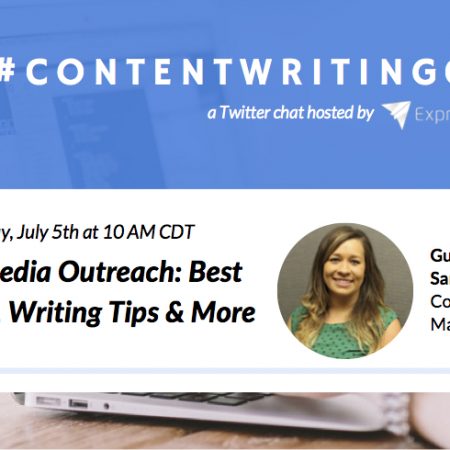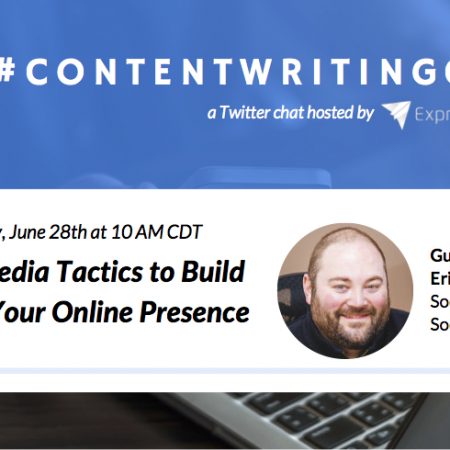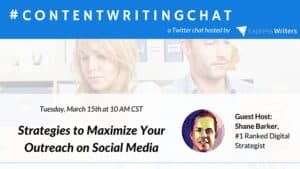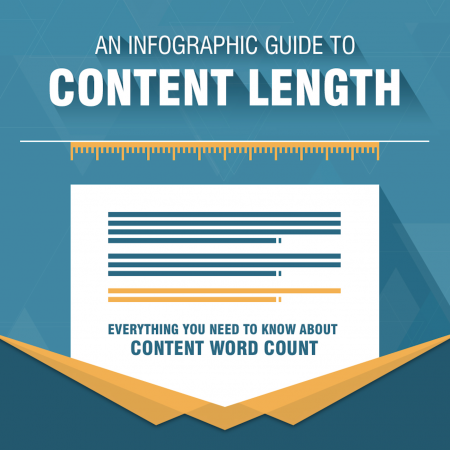
#ContentWritingChat Recap: Social Media Outreach- Best Practices, Writing Tips & More with Sprout Social
Did you miss #ContentWritingChat this week? There’s no need to worry! You can get caught up right here with our recap and learn plenty of tips for great social media outreach.
#ContentWritingChat Recap: Social Media Outreach- Best Practices, Writing Tips & More with Sprout Social
Join us for #ContentWritingChat on Tuesday, July 5th at 10 AM CDT with guest host @sprout_sarah of @SproutSocial! pic.twitter.com/hMPEfRqFsW
— Express Writers (@ExpWriters) June 28, 2016
Our guest host this week was Sarah Nagel. Sarah is the Community Outreach Manager over at Sprout Social. She also manages their Twitter chat, #SproutChat, every Wednesday on Twitter.
Q1: If you’re starting out on social, what are some best practices for building a following?
Whether you’re just starting out on social media or are working on building your presence on a new platform, check out these great tips for building your initial social media outreach:
A1- Be both interesting, interested & provide value. #contentwritingchat
— Sarah Nagel (@sprout_sarah) July 5, 2016
A1- You can do this by starting conversations, sharing smart content, joining Twitter chats, following ppl. #contentwritingchat
— Sarah Nagel (@sprout_sarah) July 5, 2016
A1- Don’t expect to gain followers at a rapid pace initially. Be patient & let it happen organically. #contentwritingchat
— Sarah Nagel (@sprout_sarah) July 5, 2016
Sarah said you should be interesting, interested, and provide value for your audience. Her advice was to start conversations with people, share smart content, and join Twitter chats.
She also reminds us that building a following won’t happen overnight. It takes times and you have to be patient.
A1: Provide useful, great content/insights. Become part of the conversation. Reach out, be nice! #ContentWritingChat https://t.co/aeo05CUHuF
— ThinkSEM (@ThinkSEM) July 5, 2016
Sarah from ThinkSEM said to provide useful, great content for your audience. It all goes back to content. If you’re not sharing the types of posts your target audience wants to read, they’ll have no reason to stick around. Don’t forget to also engage in conversation. Be social!
A1) Post and be consistent about it, especially on Facebook. Research your demo and post material that speaks to them. #ContentWritingChat
— Kyle Murray (@TheKyleMurray) July 5, 2016
Kyle said to be consistent when it comes to posting. Create a schedule and stay active when it comes to scheduling and sharing content. Kyle also said you should research your target audience so you can provide posts they’re interested in.
A1: Engage your audience so they know you’re there, and be genuine! #ContentWritingChat
— Brittany Welsh (@BrittnyWelsh) July 5, 2016
Brittany said to engage with your audience! Let them know you’re present and that you’re actually listening. You should always be genuine as well. If you’re not, they’ll see right through you.
A1a) Look for the social channel you can best own. You probably don’t need to be everywhere. #ContentWritingChat pic.twitter.com/sqliOwiVp5
— Jeff Reno(e) (@Renoe) July 5, 2016
Jenn said to look for the social media channel you can best own. The truth is, you don’t need to be everywhere when it comes to social media. You just need to be where your audience is. Figure out where they’re spending their time and which platforms you truly shine on. Those are the ones you should be using.
A1 Know where your audience lives. Don’t build on all platforms…find your best ones. Use key terms your audience uses. #ContentWritingChat
— Julia McCoy (@JuliaEMcCoy) July 5, 2016
Our CEO, Julia, agrees with Jenn. She said you don’t need to build on all platforms.
A1 Get to know your audience. What chats do they attend? What FB or LI groups do they frequent? Go there. #ContentWritingChat
— Erika Heald (@SFerika) July 5, 2016
Erika recommends figuring out where your audience is spending their time. Are they joining any Twitter chats, using Facebook groups, or using LinkedIn groups? If so, that’s where you need to be.
A1) When starting out on #SocialMedia be genuine and engage with others. Build relationships not just followers! #contentwritingchat
— Jim Carter (@MSLJim) July 5, 2016
Great answer, Jim! Be genuine and engage with others. Focus on building a relationship with people, not just gaining followers.
A1: Have a plan. Social media activities without a plan =Titanic in the social media ocean 🙂 #contentwritingchat
— Omi Sido (@OmiSido) July 5, 2016
Make sure you have a plan in place. Your plan should include which platforms you’ll use, what kind of content you’ll share, and how you can expand your reach.
A1: Create a strategized content calendar. Remember your goals and publish quality content related to it! #ContentWritingChat
— GLA Communications (@GLA_PR) July 5, 2016
Having a content calendar is a great way to stay organized when it comes to posting content on social media.
A1: It’s good practice to get to know your target audience; learn about your community and what they want/need. #contentwritingchat
— Ray Sidney-Smith (@w3consulting) July 5, 2016
Ray said to learn about your community so you can figure out what they want and need. Once you figure that out, you’ll be able to share the content that will draw them in.
Q2: What are ways to consistently grow your social media following?
Once you’ve gotten started on social media, you obviously have to work to keep the followers coming in. To help you out, here are a few tips from Tuesday’s chat:
A2- Provide unique content that means something to your audience. Be so good they can’t ignore you. #contentwritingchat
— Sarah Nagel (@sprout_sarah) July 5, 2016
Sarah said to provide unique content that means something to your audience. She said to be so good they can’t ignore you. When you share the content your audience finds valuable, they’ll want to stick around.
A2 Seek out relevant conversations with your ideal audience! Engage, engage, engage! #contentwritingchat
— Hannah Chapple (@HannahChapple) July 5, 2016
@writingchat A2 To build your social media community don’t forget to BE social! Engage w/others. Don’t just broadcast. #ContentWritingChat
— Erika Heald (@SFerika) July 5, 2016
Hannah and Erika know engagement is important to your success on social media.
A2 Engage! Engage…engage… it can’t be said enough. No world-class automation tool will replace real engagement #ContentWritingChat
— Julia McCoy (@JuliaEMcCoy) July 5, 2016
As Julia said, there isn’t an automation tool that can replace real engagement. When you take the time to talk to your audience, you form a relationship, which helps build trust.
A2: Continue reaching out to new people–don’t “settle” for a #; work for engagement/insight/etc #ContentWritingChat https://t.co/7JCksW2EhY
— ThinkSEM (@ThinkSEM) July 5, 2016
Sarah said to keep reaching out to people. Don’t just rely on hashtags to help your content be discovered. Start conversations and make connections.
A2: Be active, start conversations, jump in to a conversation. Be helpful, develop relationships! #ContentWritingChat
— Brandie McCallum (@lttlewys) July 5, 2016
Brandie’s advice was to be active on the platforms you’re using and start conversations with others. You should aim to be helpful and develop a relationship with your followers.
A2: Once you have an audience, expand it by remaining active. Share, Like, Follow, all that good stuff. #contentwritingchat
— Katria Petroff (@KatPetroff99) July 5, 2016
Katria, our Content Manager, said to be active once you’ve built a following. Make sure you’re sharing and liking content, as well as following other people.
A2: Twitter & Instagram – do your hashtag homework! Find relevant tags to use to join in conversations. MUST add value! #contentwritingchat
— Georgie Gayler (@georgie_social) July 5, 2016
Georgie recommends using relevant hashtags on Twitter and Instagram. Hashtags can help your content be discovered by new people. You should also join conversations with those using those same hashtags.
A2) Participate in #TwitterChats! An excellent way get to know others & grow connections #contentwritingchat https://t.co/ojc4mVYTc4
— Jim Carter (@MSLJim) July 5, 2016
Jim said to join Twitter chats to build your following. Not only are chats a great place to learn, but they’re helpful when it comes to making connections. If that’s not enough reason to join our chat every Tuesday, I don’t know what is!
A2: Invest in sponsored/promoted posts to put your content in front of new eyes. #contentwritingchat
— Richard Hostler (@PCC_Hostler) July 5, 2016
If you’re willing to put some cash into your social media presence, Richard recommends using paid ads to build your audience.
A2. Understand that building a ‘worthwhile’ network takes time. Don’t lose the plot, keep at it, be nice, be useful. #ContentWritingChat
— Cheryl Joy (@CherylJoy2) July 5, 2016
As Cheryl said, building a worthwhile network takes time. Don’t give up if you feel like you aren’t seeing the results you want just yet.
Q3: Share your process for creating audience-friendly social media content.
Are you in need of some tips for creating great content for your audience? Here’s some of the advice from this week’s chat:
A3- When curating, be sure that your post copy is catered to your audience. #contentwritingchat
— Sarah Nagel (@sprout_sarah) July 5, 2016
A3- For sharing your own content, keep it short, but make sure it’s either informative or entertaining. #contentwritingchat
— Sarah Nagel (@sprout_sarah) July 5, 2016
If you’re curating content, Sarah said to make sure the post copy is catered to your audience. When sharing your own content, she suggests keeping it short and being informative or entertaining.
A3a Repurposing: @redheadrachel writes fresh blurbs for old posts, which we schedule out in @Buffer. Lots of traction! #ContentWritingChat
— Julia McCoy (@JuliaEMcCoy) July 5, 2016
A3b Curating: We only share what we personally find helpful/useful/interesting from influencers in our industry. #ContentWritingChat
— Julia McCoy (@JuliaEMcCoy) July 5, 2016
Don’t forget that you can dig into your archives for great social media content. All you need to do is write fresh copy and schedule it to be shared again. As Julia pointed out, this is exactly what I do for Express Writers!
When it comes to curation, we only share content we find to be helpful, useful, or interesting. We rely on influencers in our industry for great content to share.
A3) Two words: snackable infographics. Say what you want & Give readers what they want. #contentwritingchat pic.twitter.com/qYRrrUA2FJ
— Jeff Reno(e) (@Renoe) July 5, 2016
For Jenn, she loves a “snackable” infographic. Not only are infographics informative for your audience, but they’re great for sharing too.
A3: I test what works first, then analyse the analytics and look at what content performed best across channels. Repeat! #contentwritingchat
— Georgie Gayler (@georgie_social) July 5, 2016
Georgie knows it’s important to test and see what your audience is responding to. Try new things and check your analytics to see what works and what doesn’t. Create more of the content your audience loves.
A3: Audience friendly socmed content a) reflects what people r looking 4 from yor brand &b) platform appropriate content #contentwritingchat
— Maureen Jann (@MaureenOnPoint) July 5, 2016
Maureen said audience-friendly social media content should reflect what people are looking for from your brand and also be appropriate for the platform.
@ExpWriters A3 – Don’t want to let any agency secrets out of the bag, but: A well-thought-out schedule is the way to go #contentwritingchat
— globalHMA (@globalHMA) July 5, 2016
Having a schedule in place is a great way to stay on track and will ensure you get results.
A3 Good content solves problems. It’s not a social media post. It’s a solution to someone’s problem. #contentwritingchat
— Bill Skowronski (@BillSkowronski) July 5, 2016
Bill said good content solves problems. Consider what your audience is struggling with and aim to provide a solution with your social media posts.
Q4: What are ways to write social media posts that really grab attention?
It can be hard to stand out on social media when you consider just how busy these platforms are. To grab the attention of your followers, keep these tips in mind:
A4- Any POV you can provide after digesting the content always does well. Tell your audience what the content means. #contentwritingchat
— Sarah Nagel (@sprout_sarah) July 5, 2016
Sarah said to provide your POV. It’s sure to get your audience interested and spark a conversation.
A4: Write for each platform. What is yur audience expecting/reacting to? A/B test like crazy! #contentwritingchat
— Maureen Jann (@MaureenOnPoint) July 5, 2016
Maureen recommends tailoring your content for the platform it’ll be shared on. Perform A/B tests to see what your audience is responding to.
A4: Great images. Quotes. Questions. Relevant hashtags. Tagging influencers. #ContentWritingChat https://t.co/yUXdSzwvz1
— ThinkSEM (@ThinkSEM) July 5, 2016
Sarah has a few great suggestions: images, quotes, questions, relevant hashtags, and tagging influencers.
A4 Keep them brief & always include a GIF #contentwritingchat pic.twitter.com/DOKW3iYB1k
— Brittany-dot-Social (@BrittanySocial) July 5, 2016
A4) GIFs. GIFs grab attention. Just don’t reach with them. They should work hand in hand w/ #contentwritingchat. pic.twitter.com/IbyhSHLst2
— Jeff Reno(e) (@Renoe) July 5, 2016
Brittany and Jenn know a GIF is a good way to grab the attention of your audience.
A4 Stoppingly good content is simple and poignant. It’s like art that you notice because you connect emotionally. #contentwritingchat
— Bill Skowronski (@BillSkowronski) July 5, 2016
Bill said good content is both simple and poignant. If you can create something your audience will connect with emotionally, you have a winner.
A4. Engaging content. Good images. Well-written articles. Really….tell a fantastic story. #contentwritingchat
— Brittany Brander (@BrittanyBrander) July 5, 2016
Brittany’s advice was to share engaging content. Use good images, share well-written articles, and tell a story.
A4. Conversational questions! Ask a question that aligns w/ audience’s problem. The content should be the answer #ContentWritingChat
— Julia McCoy (@JuliaEMcCoy) July 5, 2016
Julia said to ask questions on social media. Get a conversation started between you and your audience. You can ask something that aligns with their problem and solve it with your content.
Q5: How do you alter social posts to fit your platform? (Twitter vs. Facebook vs. Instagram)
Don’t forget that you need to tailor your content to the platform you’re using. Here are a few tips to help:
A5- Twitter should be search friendly, include hashtags, FB *must* have media, and Insta should be very hashtag heavy. #contentwritingchat
— Sarah Nagel (@sprout_sarah) July 5, 2016
A5- Though testing different copy & boosting where possible will help you determine what your followers like. #contentwritingchat
— Sarah Nagel (@sprout_sarah) July 5, 2016
Sarah said Twitter posts should be search-friendly and include hashtags. On Facebook, make sure you’ve included media with your posts. When sharing to Instagram, use plenty of relevant hashtags. She also advises to test different copy so you can see what actually resonates with your audience.
A5) Twitter engages, FB informs, Instagram showcases, Pinterest remembers, LinkedIn educates #contentwritingchat pic.twitter.com/dSn6K33Thw
— Jeff Reno(e) (@Renoe) July 5, 2016
Twitter engages, Facebook informs, Instagram showcases, Pinterest remembers, and LinkedIn educates. Great answer, Jenn!
A5: Test to see what works best for you on each platform and adapt your content accordingly. Don’t just cross-post. #ContentWritingChat
— Rachel (@redheadrachel) July 5, 2016
Don’t just cross-post your content to every platform you’re using. You need to adapt your posts accordingly. What works well on one platform might not perform that great on another.
A5: Carbon copy content is LAME – it’s ok to share the same content across channels but every platform has its own voice #ContentWritingChat
— Ellie Hubble (@ellie_hubble) July 5, 2016
Ellie knows carbon copy content isn’t cool. You can share the same content on multiple platforms, but change it up. Use different copy or a new visual.
A5 Have the general ideas carved out, but align to every platform, channel – in style, tone, communication, body #ContentWritingChat
— Zala Bricelj (@ZalkaB) July 5, 2016
Zala said to align to the platform you’re using by considering things such as your style and tone.
A5 Know the strengths of each platform. GIFs aren’t as effective on FB or IG but both give more freedom w/ text #contentwritingchat
— Brittany-dot-Social (@BrittanySocial) July 5, 2016
Brittany said to know the strengths of each platform. Use that to your advantage when creating content.
A5 @Canva is a great tool for social platform specific designs #contentwritingchat
— Bill Skowronski (@BillSkowronski) July 5, 2016
Visuals are powerful on social media. Bill recommends using Canva to create graphics that are the ideal size for each platform.
A5: Understand the audience on each platform. How are they looking to engage? Feed their appetite with relevant posts. #ContentWritingChat
— Ryan Clutter (@Ryan1SEO) July 5, 2016
Ryan said to understand the audience on each platform. Give them what they’re looking for.
A5. Study the data! Knowing how user behavior differs on each platform allows for tailor-fitted content, per audience. #ContentWritingChat
— Co-op Social (@co_opsocial) July 5, 2016
Study data so you can see how users behave on any given platform. Tailor your content accordingly.
Q6: What content types are the most shareable on social media?
You want your social media content to be shared, right? Here’s what you should be posting if you want to see more retweets and reposts:
A6- Video, especially short, is the most sharable. But don’t underestimate funny content. #contentwritingchat
— Sarah Nagel (@sprout_sarah) July 5, 2016
Sarah knows short videos are definitely shareable. Consider creating and posting them on your social media channels and see how your audience responds.
A6. Infographics, news and trends #ContentWritingChat
— Amalia G- Yointic (@amalein) July 5, 2016
Amalia said infographics, news, and trending topics often get a lot of shares.
A6 Content that causes emotion-humor, happiness, sadness, fear, awe gets shared most. Read Contagious by @j1berger #contentwritingchat
— Bill Skowronski (@BillSkowronski) July 5, 2016
Bill recommends sharing content that stirs up emotions in your audience. You’re more likely to get extra shares when people form a connection with your post.
A6: Long-form text is highly shareable on Medium, LinkedIn Pules, G+, etc. Images/GIFs/videos are shareable elsewhere. #contentwritingchat
— Ray Sidney-Smith (@w3consulting) July 5, 2016
Ray knows that it also depends on the platform you’re using. He said long-form content is highly shareable on Medium, LinkedIn Pulse, and Google+. Images, GIFs, and videos are shareable on other platforms.
A6 Videos (esp Vines), memes, & images. Short bits of visual content that gives the most value in the shortest time #contentwritingchat
— Brittany-dot-Social (@BrittanySocial) July 5, 2016
Brittany knows that visuals get a lot of reshares on social media. She said to try sharing videos, memes, and images.
A6: GIFs, sharp images, & quotes tend to work well for the short attn spans on SoMe. #contentwritingchat https://t.co/F3hYYnPjgC
— Eliza David, Author (@elizadwrites) July 5, 2016
You don’t have long to grab someone’s attention on social media. Eliza recommends posting GIFs, images, and quotes if you want to see a few extra shares on your content.
Q7: What key elements make up a successful social media presence?
How can you be successful on social media? Keep this advice in mind:
A7- Success will be defined differently for diff orgs, but should include an engaged audience. #contentwritingchat
— Sarah Nagel (@sprout_sarah) July 5, 2016
As Sarah said, how you define success may be different from how another organization defines success. No matter what, everyone should strive to build an engaged audience.
A7 Success is completely tied to your goals. Building an audience? Raising awareness? Driving a CTA? Entertaining? #contentwritingchat
— Bill Skowronski (@BillSkowronski) July 5, 2016
Bill seems to agree with Sarah. He said success is tied to your specific goals. What are you trying to achieve? Make sure your social media presence reflects your goals and measure to see if you’re achieving the desired results.
A7: Good social media presence=Authenticity, helpfulness, responsiveness, interaction and brand alignment. #contentwritingchat
— Maureen Jann (@MaureenOnPoint) July 5, 2016
Maureen’s advice is to be authentic, helpful, and responsive. Make sure you’re also interacting with your audience and sharing content that aligns with your brand.
A7: Sharing and interacting, it’s not just about yourself, are you involved and caring about your Community? #ContentWritingChat
— Brandie McCallum (@lttlewys) July 5, 2016
Remember that it’s not all about you! You should be sharing and interacting. Get involved in your community.
#ContentWritingChat A7: Be active! No one wants to land on an account that hasn’t been touched since 2012.
— New Jupiter Media (@NewJupiterMedia) July 5, 2016
Be active! Don’t let your account go stale. Make sure you’re posting on a daily basis.
A7: Engaging with others, sharing great content, being “real,” knowing your audience #ContentWritingChat https://t.co/ZwWHsD2B5n
— ThinkSEM (@ThinkSEM) July 5, 2016
Great tips from Sarah! Engage with others, share great content, be “real,” and know your audience.
@ExpWriters A7 – A mix of engagement, promotion, new sharing and image/videos. #contentwritingchat
— globalHMA (@globalHMA) July 5, 2016
Your social media presence should be a mix of engagement, promotion, and sharing.
A7) Engagement, Content, Engagement, Consistency, Engagement, GIFs, engagement #contentwritingchat pic.twitter.com/zG0zwAigcw
— Jeff Reno(e) (@Renoe) July 5, 2016
We think Jenn is really big on engagement. How about you?
A7. An optimized bio. Great content. Evidence of engagement. #contentwritingchat
— Brittany Brander (@BrittanyBrander) July 5, 2016
Brittany suggests writing an optimized bio, sharing great content, and engaging with your audience.
A7: A robust, effective strategy with clear objectives. That’s rule #1! Then back it up with a planned content strategy #contentwritingchat
— Georgie Gayler (@georgie_social) July 5, 2016
Georgie said to have a strategy in place with clear objectives. Back it up with an amazing content strategy.
A7: Dedication is needed for #socialmedia. It’s like manning a booth in real life. You have to commit to being there. #contentwritingchat
— AK Kerani (@AKKerani) July 5, 2016
You have to be dedicated if you want to see results. You can’t expect to build a following overnight.
Q8: How can you approach an influencer on social media to do a collaboration?
If you’re looking to get exposure for your brand and help build your own authority, you can work with influencers in your niche. Here are some tips to help you approach them:
A8-Build a relationship first by giving value. Share their content, join in their initiatives. Give without expectation #contentwritingchat
— Sarah Nagel (@sprout_sarah) July 5, 2016
A8- Instead of influencers, build relationships w/your brand champions. Their promotion & support will get you farther! #contentwritingchat
— Sarah Nagel (@sprout_sarah) July 5, 2016
Sarah recommends building a relationship with an influencer before you ask for anything. Do this by giving value. You can share their content and get involved with what they’re doing. However, she also recommends that you should also build relationships with your brand champions. They will help promote and support you as well.
A8: Follow/engage. Share their stuff. Ask a question re: their content. Get on their radar. #ContentWritingChat https://t.co/8HK2fFamRD
— ThinkSEM (@ThinkSEM) July 5, 2016
Make sure you’re following the influencer you want to work with and engaging with them regularly prior to asking for anything. You can start a conversation by asking a question regarding their content, which helps get you on their radar.
A8: Be a real person, appeal to their expertise, show value to them, above all, ask nicely. #contentwritingchat
— Maureen Jann (@MaureenOnPoint) July 5, 2016
Maureen shared a great answer, but one key thing to keep in mind is to always be nice.
A8 Understand who they are, and what kind of collaboration would make sense for their audience. #DoYourHomework
#contentwritingchat— Erika Heald (@SFerika) July 5, 2016
Erika said to understand who the influencer is, as well as what kind of collaboration would make sense for their audience.
A8 Approach influencers from a win-win position. Collaboration isn’t a sale on either end. It’s mutually beneficial. #contentwritingchat
— Bill Skowronski (@BillSkowronski) July 5, 2016
Collaboration should be mutually beneficial for you and the influencer.
A8. Get their attention, focus on building a relationship, have something of value to offer them in return. #ContentWritingChat
— Epictions (@epictions) July 5, 2016
Focus on building a relationship prior to asking for anything in return.
A8: Give thoughtful feedback too. Add to or challenge ideas to win their respect. Don’t just write “Amazing!” #ContentWritingChat
— Zachary Fenell (@zacharyfenell) July 5, 2016
Zachary said to provide thoughtful feedback to the influencer, not just a generic “amazing.”
A8 Jab Jab Jab right hook – @garyvee. Give x 3, then ask. Engage/offer them something first, THEN ask for their collab #ContentWritingChat
— Julia McCoy (@JuliaEMcCoy) July 5, 2016
As Gary Vaynerchuk says: jab, jab, jab, right hook. Engage and offer something of value before you pitch.
We look forward to seeing you at the next #ContentWritingChat! Mark your calendars weekly for Tuesday at 10 AM CDT for great chats centered around content writing and marketing. Follow @ExpWriters to stay updated on our new topics and guests!





